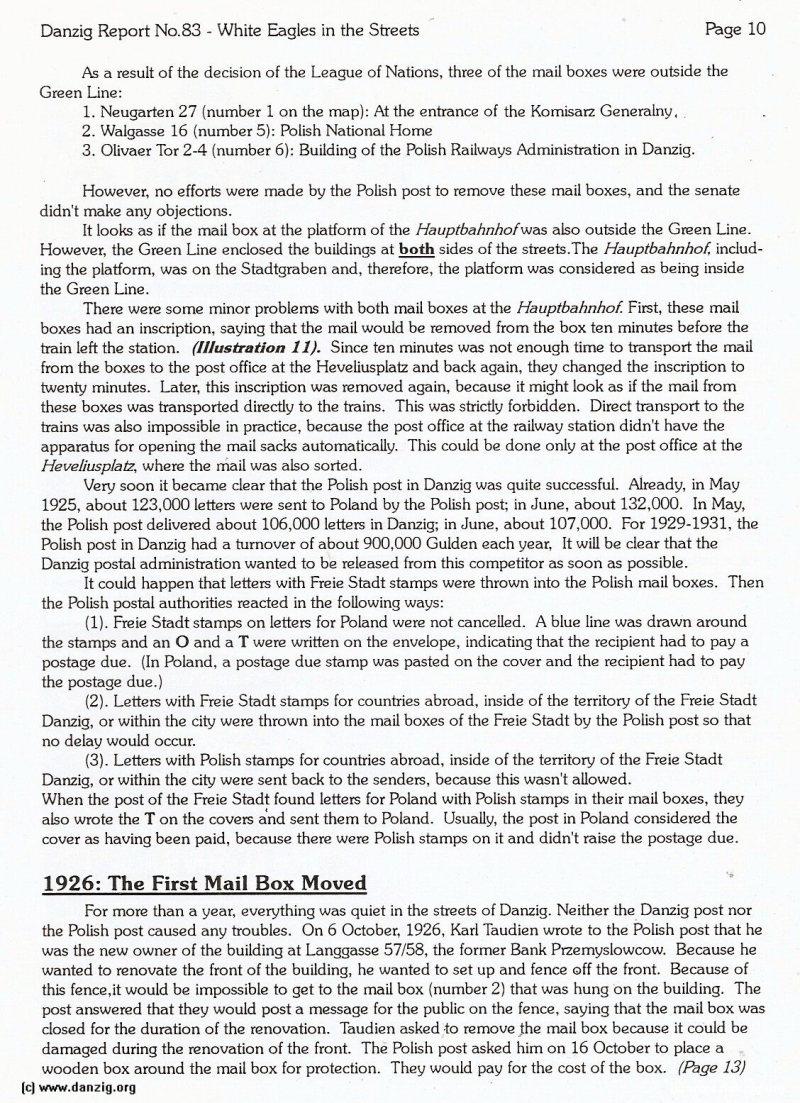
As a result of the decision of the League of Nations, three of the mail boxes were outside the Green line:
1. Neugarten 27 (number 1 on the map): At the entrance of the Komisarz Generalny,
2. Walgasse 16 (number 5): Polish National Home
3. Olivaer Tor 2-4 (number 6): Building of the Polish Railways Administration in Danzig.
However, no efforts were made by the Polish post to remove these mail boxes, and the senate didn’t make any objections.
It looks as if the mail box at the platform of the Hauptbahnhof was also outside the Green line. However, the Green Line enclosed the buildings at both sides of the streets.The Haupfbahnhol indudi ng the platform, was on the Stadtgraben and, therefore, the platform was considered as being inside the Green Line.
There were some minor problems with both mail boxes at the Hauptbahnhot First, these mail boxes had an inscription, saying that the mail would be removed from the box ten minutes before the train left the station. (Illustration 11,). Since ten minutes was not enough time to transport the mail from the boxes to the post office at the Heveliusplatz and back again, they changed the inscription to twenty minutes. Later, this inscription was removed again, because it might look as if the mail from these boxes was transported directly to the trains. This was strictly forbidden. Direct transport to the trains was also impossible in practice, because the post office at the railway station didn’t have the apparatus for opening the mail sacks automatically. This could be done only at the post office at the Heveliusplatz, where the mail was also sorted.
Very soon it became clear that the Polish post in Danzig was quite successful. Already, in May 1925, about 123,000 letters were sent to Poland by the Polish post; in June, about 132,000. In May, the Polish post delivered about 106,000 letters in Danzig; in June, about 107,000. For 1929-1931, the Polish post in Danzig had a turnover of about 900,000 Gulden each year, It will be clear that the Danzig postal administration wanted to be released from this competitor as soon as possible.
It could happen that letters with Freie Stadt stamps were thrown into the Polish mail boxes. Then the Polish postal authorities reacted in the following ways:
(1). Freie Stadt stamps on letters for Poland were not cancelled. A blue line was drawn around the stamps and an 0 and a T were written on the envelope, indicating that the recipient had to pay a postage due. (In Poland, a postage due stamp was pasted on the cover and the recipient had to pay the postage due.)
(2). Letters with Freie Stadt stamps for countries abroad, inside of the territory of the Freie Stadt Danzig, or within the city were thrown into the mail boxes of the Freie Stadt by the Polish post so that no delay would occur.
(3). Letters with Polish stamps for countries abroad, inside of the territory of the Freie Stadt Danzig, or within the city were sent back to the senders, because this wasn’t allowed.
When the post of the Freie Stadt found letters for Poland with Polish stamps in their mail boxes, they also wrote the T on the covers and sent them to Poland. Usually, the post in Poland considered the cover as having been paid, because there were Polish stamps on it and didn’t raise the postage due.
For more than a year, everything was quiet in the streets of Danzig. Neither the Danzig post nor the Polish post caused any troubles. On 6 October, 1926, Karl Taudien wrote to the Polish post that he was the new owner of the building at Langgasse 57/58, the former Bank Przemyslowcow. Because he wanted to renovate the front of the building, he wanted to set up and fence off the front. Because of this fence,it would be impossible to get to the mail box (number 2) that was hung on the building. The post answered that they would post a message for the public on the fence, saying that the mail box was dosed for the duration of the renovation. Taudien asked to remove the mail box because it could be damaged during the renovation of the front. The Polish post asked him on 16 October to place a wooden box around the mail box for protection. They would pay for the cost of the box. (Page 13)
Danzig Report Vol. 1 - Nr. 83 - April - May - June - 1994, Page 10.
Hits: 4017
Added: 09/07/2015
Copyright: 2025 Danzig.org

